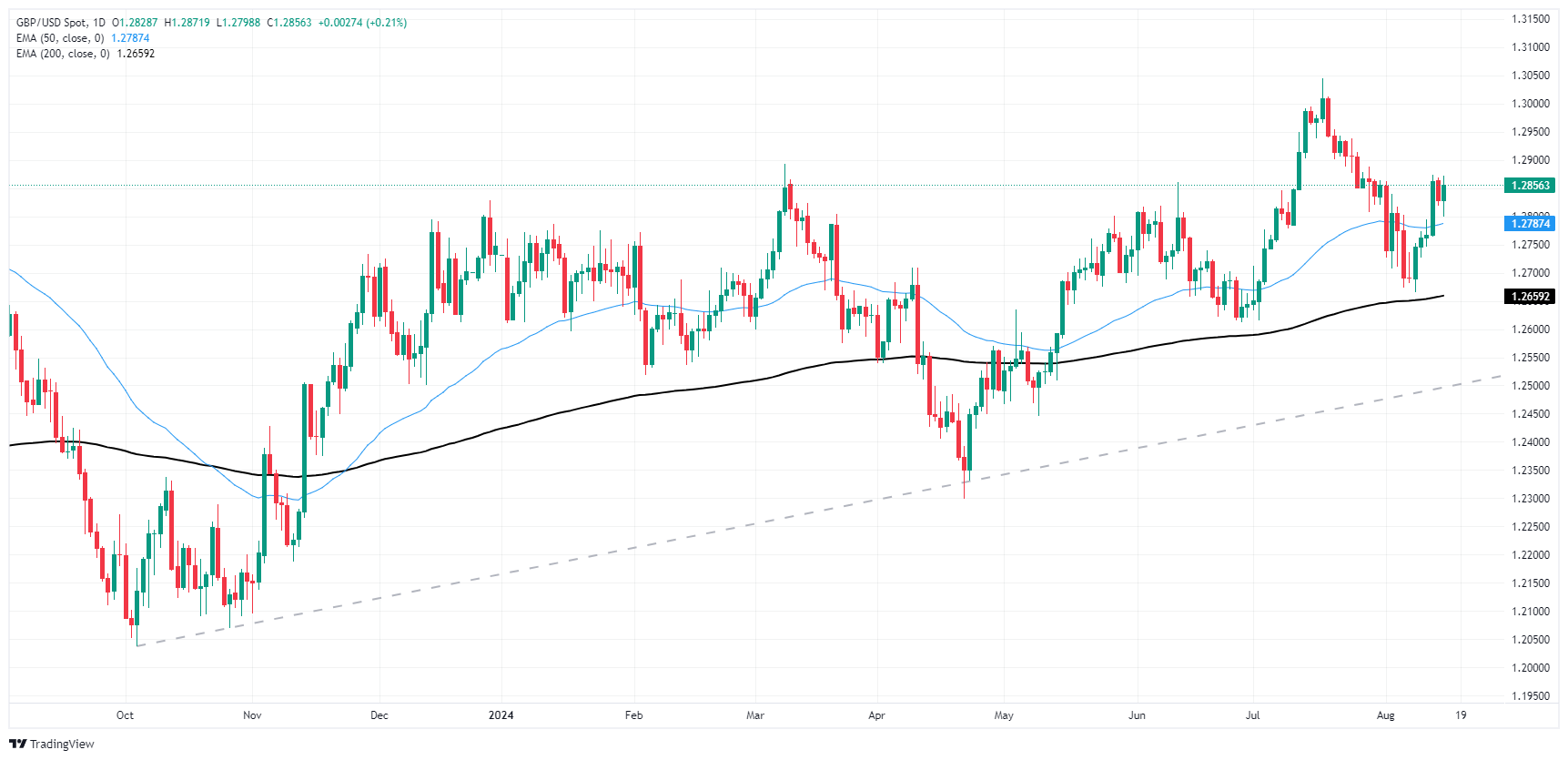GBP/USD bulls aim for 1.2900 amid risk appetite recovery
- GBP/USD halts downside turnaround, finds another green day.
- UK GDP and industrial activity meet or beat expectations, US Retail Sales surge.
- UK Retail Sales and US Consumer Sentiment on the docket for Friday.
GBP/USD found the gas pedal on Thursday after a steeper-than-expected recovery in US Retail Sales pushed Cable back into the high end. Market sentiment rebounded on the day after fears of a possible US recession were cooled by US data beating expectations, and the Pound Sterling caught additional bullish momentum from UK Gross Domestic Product (GDP) growth meet expectations and UK Manufacturing Production handily exceeding forecasts in July.
Coming up on Friday, UK Retail Sales are expected to rebound from a recent downswing. MoM Retail Sales in July are forecast to rise to 0.5% after the previous month’s -1.2% contraction, with the YoY figure expected to surge to 1.4% from the previous -0.2% contraction. On the US side, the University of Michigan’s Consumer Sentiment Survey Index is expected to show an improvement in consumer economic expectations, with the figure forecast to tick up to 66.9 from an eight-month low of 66.4.
Economic Indicator
Retail Sales (MoM)
The Retail Sales data, released by the US Census Bureau on a monthly basis, measures the value in total receipts of retail and food stores in the United States. Monthly percent changes reflect the rate of changes in such sales. A stratified random sampling method is used to select approximately 4,800 retail and food services firms whose sales are then weighted and benchmarked to represent the complete universe of over three million retail and food services firms across the country. The data is adjusted for seasonal variations as well as holiday and trading-day differences, but not for price changes. Retail Sales data is widely followed as an indicator of consumer spending, which is a major driver of the US economy. Generally, a high reading is seen as bullish for the US Dollar (USD), while a low reading is seen as bearish.
Read more.Last release: Thu Aug 15, 2024 12:30
Frequency: Monthly
Actual: 1%
Consensus: 0.3%
Previous: 0%
Source: US Census Bureau
Retail Sales data published by the US Census Bureau is a leading indicator that gives important information about consumer spending, which has a significant impact on the GDP. Although strong sales figures are likely to boost the USD, external factors, such as weather conditions, could distort the data and paint a misleading picture. In addition to the headline data, changes in the Retail Sales Control Group could trigger a market reaction as it is used to prepare the estimates of Personal Consumption Expenditures for most goods.
GBP/USD technical outlook
Cable’s bullish recovery on Thursday gave the pair the help it needed to remain on the high side of the 50-day Exponential Moving Average (EMA) 1.2787. GBP/USD caught a technical bounce after hitting the 1.2800 handle early Thursday, but bulls ran out of steam just before they could chalk in a fresh two-week high. Intraday price action is churning just north of 1.2850.
GBP/USD daily chart

Pound Sterling FAQs
The Pound Sterling (GBP) is the oldest currency in the world (886 AD) and the official currency of the United Kingdom. It is the fourth most traded unit for foreign exchange (FX) in the world, accounting for 12% of all transactions, averaging $630 billion a day, according to 2022 data. Its key trading pairs are GBP/USD, aka ‘Cable’, which accounts for 11% of FX, GBP/JPY, or the ‘Dragon’ as it is known by traders (3%), and EUR/GBP (2%). The Pound Sterling is issued by the Bank of England (BoE).
The single most important factor influencing the value of the Pound Sterling is monetary policy decided by the Bank of England. The BoE bases its decisions on whether it has achieved its primary goal of “price stability” – a steady inflation rate of around 2%. Its primary tool for achieving this is the adjustment of interest rates. When inflation is too high, the BoE will try to rein it in by raising interest rates, making it more expensive for people and businesses to access credit. This is generally positive for GBP, as higher interest rates make the UK a more attractive place for global investors to park their money. When inflation falls too low it is a sign economic growth is slowing. In this scenario, the BoE will consider lowering interest rates to cheapen credit so businesses will borrow more to invest in growth-generating projects.
Data releases gauge the health of the economy and can impact the value of the Pound Sterling. Indicators such as GDP, Manufacturing and Services PMIs, and employment can all influence the direction of the GBP. A strong economy is good for Sterling. Not only does it attract more foreign investment but it may encourage the BoE to put up interest rates, which will directly strengthen GBP. Otherwise, if economic data is weak, the Pound Sterling is likely to fall.
Another significant data release for the Pound Sterling is the Trade Balance. This indicator measures the difference between what a country earns from its exports and what it spends on imports over a given period. If a country produces highly sought-after exports, its currency will benefit purely from the extra demand created from foreign buyers seeking to purchase these goods. Therefore, a positive net Trade Balance strengthens a currency and vice versa for a negative balance.